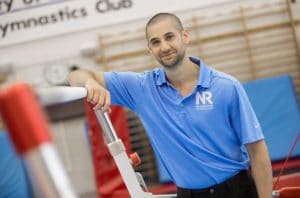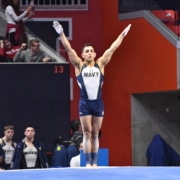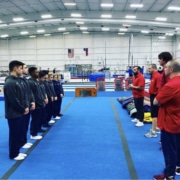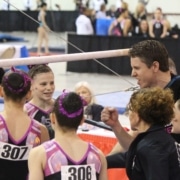Turning Toxic Gym Environments to World Class Cultures – A “10 Quick Tips” Guest Post by Nick Ruddock
Today, I’m incredibly excited to be featuring a long-awaited guest post from my good friend Nick Ruddock. In my 20 years of gymnastics, I’ve been fortunate to witness some of the most incredible examples of world-class training environments. I also, unfortunately, have seen my fair share of unhealthy gym environments that undermine both performance and health of young athletes. Too often we are attempting to fix culture problems with more drills, skills, routines, strength, and flexible circuits.
This topic is unbelievably important. Given Nick’s background as an Olympic level gymnastics coach, and current sports performance consultant to over 20 nations, he knows a thing or two about building the ideal training environment. This is why I asked if he would share his thoughts. When approached correctly, the right training culture allows a gym to produce healthy and happy athletes, who at the same time can reach elite levels of sports performance. Do yourself a favor and read this one twice. Enjoy! – Dave
In Gymnastics (and all sports), we can talk about physical and technical preparation and drills all day long, but if the culture of your gym isn’t right, sustainable results won’t come to fruition.
First, let’s ensure we understand what ‘culture is.’ By dictionary definition, a culture is ‘the ideas, customs, and social behavior of a particular people or society.’
It’s the way you do things, the environment you train in, the attitudes of your people.
I’ve been fortunate to have visited, worked and consulted in around 20 nations and therefore have stepped into thousands of gyms and other professional sports environments also.
I’ve witnessed world-class cultures and spent time in low performing, toxic cultures too. Here are my ten quick tips on the subject:
-
Table of Contents
It All Starts With a Vision
The first step is always to understand exactly what you are working towards. What does a world-class culture look and feel like? If you were standing on the balcony watching over a gym with a fantastic culture what would you notice? What behaviors do the athletes, coaches, and staff demonstrate? Once there is clarity on this, clubs can begin to work towards reaching that same level within their own environments. Another great exercise is to ‘audit’ your current culture without your club, bringing all key stakeholders together to collectively discuss the gaps, challenges, and changes that need to be made.
-
INVEST Time in Communicating Your Culture
Walk in to any Starbucks or Apple store and you’ll understand their culture straight away. It starts with their values, what defines them as an organization and how they want to be perceived. They are consistent with their behaviors, across all the hundreds of thousands of chains around the world. You know what you are getting when you walk in. For a global culture to be created of that size, they need robust systems and educational interventions to train staff and hire them based on their cultural fit for their organization. In gymnastics terms, that means training your staff about your values and philosophies and enforcing these behaviors. Coaches don’t let their athletes get away with poor performance, staff shouldn’t get away with it either. It begins with education.
A great example of proactive education on staff culture is from my good friend Richard Dwyer, CEO of Flair Gymnastics, one of the UK’s leading Gymnastics organizations. Check out this quick video as an example https://www.youtube.com/watch?v=eCrPt1dx0bg
-
Leadership Should be Demonstrated at All Levels
Your coaches may be enforcing and cultivating the culture, but the athletes are a huge part of demonstrating the values, philosophies, and behaviors also. By being raised in an excellent culture, they will adopt these behaviors for life, and help to educate the next generation of athletes coming through the system also. Have regular short ‘pep talks’ as a way of reminding the athletes about the ‘way you do things’ and more importantly WHY. Recognise moments of great behavior from both athlete and coach. It could be as simple as an athlete holding a door open for somebody, helping them move equipment without being asked, getting their grips on super fast, or encouraging another athlete who is having a bad day. When leadership is demonstrated at all levels, the culture becomes outstandingly effective.
-
It’s Your Ship
Once a customer, member of staff or athlete walks through your building doors, they are effectively in your home. Once in your home, they should abide by your rules. If you haven’t educated your visitors on the way you do things and what you expect from them, then it may be difficult to cultivate a great culture. This is particularly important for ensuring the behavior of parents is in line with your expectations. If it’s not, address the situation professionally, as early as possible, linking back to the value and philosophies of the gym. ‘Deal with the small before it becomes large.’
-
Be Accountable
Linking closely to above, it’s essential that staff take accountability for the state of the club culture and avoid blaming others for how it is. If athletes don’t demonstrate great behaviors, take responsibility for that and understand that there could have been some opportunities missed for failing to educate the athletes better or sooner. The ‘blame game’ is a toxic game to play and does nothing for establishing a better environment. Remember they are in your home, and you get what you tolerate. It’s your ship.
-
Develop ‘Buy In.’
If cultural goals are dictated from the top down there will be little change in behaviors. There needs to be ‘buy-in’ and for that to happen, everybody needs to feel they have contributed to the mission and understood it clearly. A task that has been successful for several of my clients is developing a ‘Champions Charter.’ Coaches and athletes have come together to discuss the behaviors they all feel are most conducive to achieving the goals and fostering a great environment. These are NOT perceived as rules (kids hate those.) We tend to stick to 10-12 behaviors, and have the athletes come up with these (it may need some guided discovery from the coaching team.) Once agreed, it’s blown up on a huge poster, put on the wall where everybody can see it, and signed right there from all the athletes and coaches. It’s only a great tool if the behaviors are reinforced by the coaching team and referred to frequently (either proactively or reactively.) If your behavior is not congruent to the agreed Charter, then a discussion takes place.
-
Be a Role Model
One of my favorite quotes, and one that has made me think a lot about my coaching is – ‘It is foolish to expect a young athlete to follow your advice yet ignore your example.’ That’s a powerful quote. If coaches and other staff are not demonstrating the desired behaviors of your gym, don’t expect your athletes to either.
-
Encourage Diversity
Many people believe that a team should be filled with people who all think alike. I tend to disagree. Whilst a team should all be on the same mission and share some key values, it’s the diversity of a group of people that will create fantastic conversations, innovation, ideas and thus makes progress. If everybody thinks alike, then only one of you is needed! Give everybody a voice, encourage ‘safe conflict’ and respect one another’s opinion.
-
Remove Toxicity
Perhaps one of the most critical points here. Toxic people can infect a culture far quicker than you can develop one. ‘Little leaks sink the ship.’ That could be a parent, coach or athlete. Follow a process of addressing toxicity, and if it fails to change, don’t hesitate to offer those individuals an alternative venue to work or train. It’s a disservice to your hard-working, compliant athletes to allow toxic individuals to hinder their chance of fulfilling their potential. Many clubs aren’t prepared to do this if the athlete is talented, but that’s a violation of values and demonstrates that medals are more important than morale and methods. If that is the case, re-visiting point number one is vital (what is the vision?)
-
Avoid the 3 C’s
The three C’s – Complaining, Comparing and Criticizing are toxic behaviors that typically derive from energy vampires. Through a process of ‘emotional contagion,’ in which we are influenced by the attitudes and behaviors of others, we will over time be affected by having these individuals around. Stamp it out.
Culture isn’t about rigid rules, threatening coaching or forcing people to act a certain way, it’s about developing an environment that organically creates great behaviours that are of benefit to everybody involved. It’s about educating and communicating best practice, high performing behaviors and the rationale behind doing things this way. It’s about inspiring and motivating people to be the best versions of themselves possible and celebrating when these things fall into place.
Culture is as important as technique, drills and other sport-specific topics that we tend to be magnetized towards. Get it right and you could find long-term, sustainable results, and a lot more fun on the way.
Thanks for reading.
Bio –
Nick Ruddock

“Nick Ruddock contributed to historic medal winning performances on the international stage throughout his four-year term with British Gymnastics as National Coach. Nick represented Great Britain and Team GB on numerous occasions throughout his national coaching role, culminating with the 2014 Junior European Championships, where the British girls captured a historic six-medal haul including a record Team Silver ahead of European superpower Romania.
Nick, a former personal coach to Amy Tinkler; European, World and Olympic Medallist, has been mentored by some of the world’s most experienced and accomplished coaches throughout several influential countries.
Nick has lectured as a Technical Expert for the UEG (Union of European Gymnastics) for 7 years, and has consulted for over a dozen international gymnastics federations and a variety of performance sports, with a mission of optimizing athlete and coach performance for the world stage.
For more information on Nick’s services, including online courses, conferences, events and coaching programmes, visit www.nickruddock.com”









